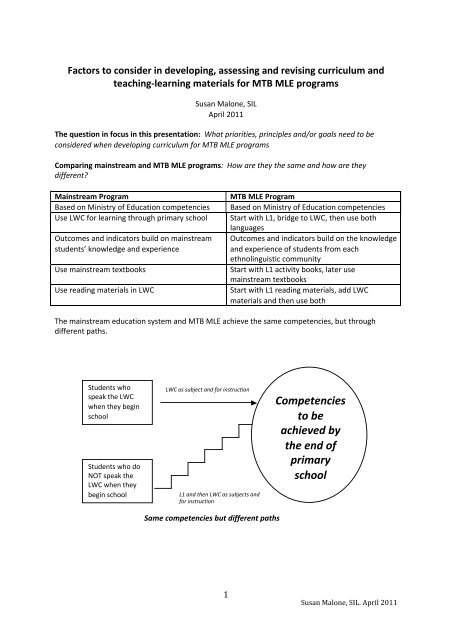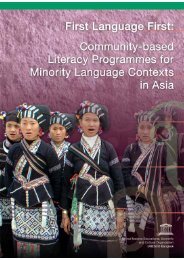Factors to consider in developing MTB MLE curriculum.pdf
Factors to consider in developing MTB MLE curriculum.pdf
Factors to consider in developing MTB MLE curriculum.pdf
You also want an ePaper? Increase the reach of your titles
YUMPU automatically turns print PDFs into web optimized ePapers that Google loves.
<strong>Fac<strong>to</strong>rs</strong> <strong>to</strong> <strong>consider</strong> <strong>in</strong> develop<strong>in</strong>g, assess<strong>in</strong>g and revis<strong>in</strong>g <strong>curriculum</strong> and <br />
teach<strong>in</strong>g-‐learn<strong>in</strong>g materials for <strong>MTB</strong> <strong>MLE</strong> programs <br />
Susan Malone, SIL <br />
April 2011 <br />
The question <strong>in</strong> focus <strong>in</strong> this presentation: What priorities, pr<strong>in</strong>ciples and/or goals need <strong>to</strong> be <br />
<strong>consider</strong>ed when develop<strong>in</strong>g <strong>curriculum</strong> for <strong>MTB</strong> <strong>MLE</strong> programs <br />
Compar<strong>in</strong>g ma<strong>in</strong>stream and <strong>MTB</strong> <strong>MLE</strong> programs: How are they the same and how are they <br />
different <br />
Ma<strong>in</strong>stream Program <br />
Based on M<strong>in</strong>istry of Education competencies <br />
Use LWC for learn<strong>in</strong>g through primary school <br />
Outcomes and <strong>in</strong>dica<strong>to</strong>rs build on ma<strong>in</strong>stream <br />
students’ knowledge and experience <br />
Use ma<strong>in</strong>stream textbooks <br />
Use read<strong>in</strong>g materials <strong>in</strong> LWC <br />
<strong>MTB</strong> <strong>MLE</strong> Program <br />
Based on M<strong>in</strong>istry of Education competencies <br />
Start with L1, bridge <strong>to</strong> LWC, then use both <br />
languages <br />
Outcomes and <strong>in</strong>dica<strong>to</strong>rs build on the knowledge <br />
and experience of students from each <br />
ethnol<strong>in</strong>guistic community <br />
Start with L1 activity books, later use <br />
ma<strong>in</strong>stream textbooks <br />
Start with L1 read<strong>in</strong>g materials, add LWC <br />
materials and then use both <br />
The ma<strong>in</strong>stream education system and <strong>MTB</strong> <strong>MLE</strong> achieve the same competencies, but through <br />
different paths. <br />
Students who <br />
speak the LWC <br />
when they beg<strong>in</strong> <br />
school <br />
Students who do <br />
NOT speak the <br />
LWC when they <br />
beg<strong>in</strong> school <br />
LWC as subject and for <strong>in</strong>struction <br />
L1 and then LWC as subjects and <br />
for <strong>in</strong>struction <br />
Competencies <br />
<strong>to</strong> be <br />
achieved by <br />
the end of <br />
primary <br />
school <br />
Same competencies but different paths <br />
1 <br />
Susan Malone, SIL. April 2011
Questions <strong>to</strong> <strong>consider</strong> <strong>in</strong> assess<strong>in</strong>g <strong>MTB</strong> <strong>MLE</strong> <strong>curriculum</strong>, teach<strong>in</strong>g and learn<strong>in</strong>g materials. <br />
• In general, are they theoretically sound—based on recognized and accepted theories of <br />
learn<strong>in</strong>g, theories of read<strong>in</strong>g acquisition and theories of language acquisition <br />
• Do they focus on the 3 types of development that are central <strong>to</strong> strong <strong>MTB</strong> <strong>MLE</strong> programs <br />
o Language development: Students are fluent <strong>in</strong> oral and written L1 & LWC and <br />
confident <strong>in</strong> us<strong>in</strong>g both languages for everyday communication and for learn<strong>in</strong>g <strong>in</strong> <br />
school. <br />
o Academic development: Students achieve MOE competencies for each grade and <br />
are confident, successful learners. <br />
o Socio-‐cultural development: Students are proud <strong>to</strong> be both members of their <br />
heritage community and <strong>to</strong> be citizens of the nation. <br />
• Do they encourage students <strong>to</strong> use higher level th<strong>in</strong>k<strong>in</strong>g (focus on mean<strong>in</strong>g) <strong>in</strong> addition <strong>to</strong> <br />
build<strong>in</strong>g their capacity <strong>to</strong> remember and repeat what is taught (focus on accuracy) <br />
• Do they <strong>in</strong>clude a specific (theoretically sound) process for help<strong>in</strong>g students <strong>to</strong> build fluency <br />
and competence <strong>in</strong> us<strong>in</strong>g “everyday” and then “academic” L1 and L2 <br />
• Are they specifically and clearly aligned with MOE competencies <br />
• Do they <strong>in</strong>corporate and build on the knowledge and experiences of the L1 community by <br />
<strong>in</strong>clud<strong>in</strong>g them <strong>in</strong> the activities and materials for each subject <br />
Government <br />
competencies <br />
established for <br />
each grade <br />
and <br />
Knowledge and <br />
experience from <br />
the students’ <br />
home culture <br />
<strong>MTB</strong> <strong>MLE</strong>-‐specific <br />
learn<strong>in</strong>g outcomes <br />
established for <br />
each grade <strong>in</strong> the <br />
program <br />
Indica<strong>to</strong>rs for each <br />
learn<strong>in</strong>g outcome that <br />
focus on mean<strong>in</strong>g <br />
(higher-‐level th<strong>in</strong>k<strong>in</strong>g) <br />
and on accuracy <br />
Lesson plans and <br />
teachers’ guides that <br />
are matched <strong>to</strong> <br />
<strong>in</strong>dica<strong>to</strong>rs and are <br />
‘teacher-‐friendly” <br />
Textbooks and other <br />
learn<strong>in</strong>g materials <br />
matched <strong>to</strong> Outcomes and <br />
Indica<strong>to</strong>rs <br />
2 <br />
Susan Malone, SIL. April 2011
Pr<strong>in</strong>ciples <strong>to</strong> guide <strong>curriculum</strong> and materials development for successful <strong>MTB</strong> BE programs <br />
• What does it mean <strong>to</strong> “learn” someth<strong>in</strong>g <br />
• How are we changed when we learn someth<strong>in</strong>g that we had not known before <br />
What difference does it make <strong>to</strong> us <br />
• The foundational pr<strong>in</strong>ciple for successful learn<strong>in</strong>g is this: We learn best when we can <br />
use what we know <strong>to</strong> understand and use new ideas and <strong>in</strong>formation. <br />
•<br />
Follow<strong>in</strong>g is a brief review of basic education pr<strong>in</strong>ciples that help students become <br />
successful, confident, life-‐long learners. How can you use these pr<strong>in</strong>ciples <strong>to</strong> plan <strong>curriculum</strong> <br />
and develop teach<strong>in</strong>g and learn<strong>in</strong>g materials for this <strong>MTB</strong>BE program <br />
Pr<strong>in</strong>ciple 1: <br />
Learn<strong>in</strong>g requires mean<strong>in</strong>g. We learn when we use what we know—our “prior knowledge” <br />
or “schema” <strong>to</strong> help us understand what is new. Beg<strong>in</strong>n<strong>in</strong>g with what the learner knows, <br />
helps them connect the new ideas, vocabulary, skills <strong>to</strong> what they already know and do, and <br />
make it easy <strong>to</strong> remember. <br />
Application: Plan activities that use the knowledge and experience students br<strong>in</strong>g <strong>to</strong> class as <br />
the foundation for <strong>in</strong>troduc<strong>in</strong>g new ideas and <strong>in</strong>formation <br />
Pr<strong>in</strong>ciple 2: <br />
We learn when a more knowledgeable person provides opportunities that help us discover <br />
new ideas and <strong>in</strong>formation. <br />
Application: Focus early learn<strong>in</strong>g on build<strong>in</strong>g students’ awareness and use of the knowledge <br />
that they br<strong>in</strong>g <strong>to</strong> school from the community. Then plan activities that encourage them <br />
work <strong>to</strong>gether, us<strong>in</strong>g their comb<strong>in</strong>ed knowledge, <strong>to</strong> discover new concepts (“discovery <br />
learn<strong>in</strong>g”). <br />
3 <br />
Susan Malone, SIL. April 2011
Pr<strong>in</strong>ciple 3: <br />
When we truly learn someth<strong>in</strong>g, we can expla<strong>in</strong> it, apply it, analyze it, evaluate it and use it <br />
creatively. <br />
Remember <br />
Repeat what <br />
we hear or <br />
read <br />
Understand <br />
Expla<strong>in</strong> what <br />
we hear or <br />
read <br />
Apply <br />
Use what we <br />
hear or read <br />
Analyze <br />
Exam<strong>in</strong>e <br />
what we <br />
learn <strong>to</strong> <br />
discover <br />
patterns <br />
Evaluate <br />
Assess what <br />
we hear or <br />
read <br />
Create <br />
Use what we <br />
learn <strong>to</strong> <br />
discover, <br />
<strong>in</strong>vent, and <br />
create <br />
Application: In all subjects, focus on activities that encourage students <strong>to</strong> use higher level <br />
th<strong>in</strong>k<strong>in</strong>g. <br />
Pr<strong>in</strong>ciple 4: <br />
We learn a language (and other subjects) successfully when we can give equal attention <strong>to</strong> <br />
mean<strong>in</strong>g and accuracy. <br />
Application: Develop learn<strong>in</strong>g activities and materials that that focus equally on mean<strong>in</strong>g <br />
(higher level th<strong>in</strong>k<strong>in</strong>g) and accuracy. <br />
Pr<strong>in</strong>ciple 5: <br />
Children learn best through peer <strong>in</strong>teractions <strong>in</strong> which they work <strong>to</strong>gether creatively <strong>to</strong> solve <br />
problems (the “discovery” learn<strong>in</strong>g aga<strong>in</strong>!) <br />
4 <br />
Susan Malone, SIL. April 2011
Application: Do most class activities <strong>in</strong> teams or pairs. Encourage students <strong>to</strong> talk with each <br />
other and compare ideas <strong>in</strong> order <strong>to</strong> solve problems <br />
From a magaz<strong>in</strong>e article… <br />
“Surpris<strong>in</strong>gly, what looks like work is actually fun. Not so surpris<strong>in</strong>g say cognitive <br />
scientists because your bra<strong>in</strong> loves solv<strong>in</strong>g puzzles. That’s how it learns. It thrives on bursts of <br />
pleasure that are part of the bra<strong>in</strong>’s reward system when you solve problems and <br />
challenges.” <br />
[from a Rosetta S<strong>to</strong>ne advertisement <strong>in</strong> Foreign Affairs, vol. 89(2), March-‐April 2010] <br />
Pr<strong>in</strong>ciple 6: <br />
Talk<strong>in</strong>g helps us make sense of new ideas and <strong>in</strong>formation <br />
Application: <br />
1) Ask good questions that encourage students <strong>to</strong> th<strong>in</strong>k & talk; <br />
2) Provide many opportunities for them <strong>to</strong> work <strong>in</strong> teams, shar<strong>in</strong>g and compar<strong>in</strong>g their ideas <br />
and solv<strong>in</strong>g problems <strong>to</strong>gether; <br />
3) Encourage them <strong>to</strong> help each other, <strong>in</strong>clud<strong>in</strong>g translat<strong>in</strong>g for each other as necessary. <br />
Pr<strong>in</strong>ciple 7: <br />
We learn a new language best when the learn<strong>in</strong>g process is non-‐threaten<strong>in</strong>g and mean<strong>in</strong>gful <br />
and when we can take “small steps” that help us ga<strong>in</strong> confidence <strong>in</strong> our ability use the <br />
language mean<strong>in</strong>gfully. <br />
Application: Beg<strong>in</strong> the L2 language learn<strong>in</strong>g time by focus<strong>in</strong>g on “hear-‐see-‐do” activities <br />
that enable students <strong>to</strong> build up their “listen<strong>in</strong>g vocabulary” before they are expected <strong>to</strong> talk. <br />
Introduce read<strong>in</strong>g and writ<strong>in</strong>g <strong>in</strong> L2 only when they have built up a good hear<strong>in</strong>g and <br />
speak<strong>in</strong>g vocabulary. <br />
5 <br />
Susan Malone, SIL. April 2011
















